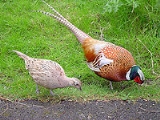
Sexual dimorphism
Overview
Sexual dimorphism is a phenotypic
difference between males and females of the same species
. Examples of such differences include differences in morphology
, ornamentation
, and behavior
.
A common type of dimorphism is ornamentation. Dichromatism is where a sex of a given species is more than one color including that of saturated, vibrant hues.
Exaggerated dimorphic traits are used predominantly in the competition over mates.
Phenotype
A phenotype is an organism's observable characteristics or traits: such as its morphology, development, biochemical or physiological properties, behavior, and products of behavior...
difference between males and females of the same species
Species
In biology, a species is one of the basic units of biological classification and a taxonomic rank. A species is often defined as a group of organisms capable of interbreeding and producing fertile offspring. While in many cases this definition is adequate, more precise or differing measures are...
. Examples of such differences include differences in morphology
Morphology (biology)
In biology, morphology is a branch of bioscience dealing with the study of the form and structure of organisms and their specific structural features....
, ornamentation
Biological ornament
A biological ornament is a structure of an animal that appears to serve a decorative function rather than an ostensible, utilitarian function. Ornaments are used in displays to attract mates. An animal may shake, lengthen, or spread out its ornament in order to get the attention of the opposite...
, and behavior
Behavior
Behavior or behaviour refers to the actions and mannerisms made by organisms, systems, or artificial entities in conjunction with its environment, which includes the other systems or organisms around as well as the physical environment...
.
A common type of dimorphism is ornamentation. Dichromatism is where a sex of a given species is more than one color including that of saturated, vibrant hues.
Exaggerated dimorphic traits are used predominantly in the competition over mates.
Unanswered Questions

